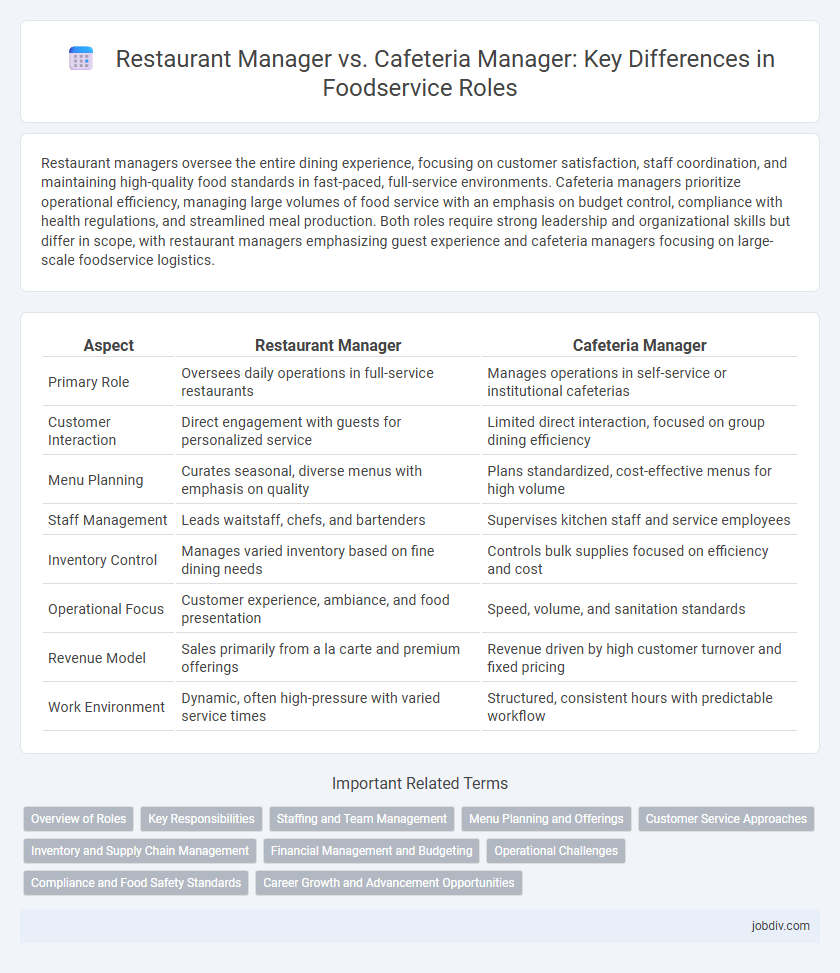Restaurant managers oversee the entire dining experience, focusing on customer satisfaction, staff coordination, and maintaining high-quality food standards in fast-paced, full-service environments. Cafeteria managers prioritize operational efficiency, managing large volumes of food service with an emphasis on budget control, compliance with health regulations, and streamlined meal production. Both roles require strong leadership and organizational skills but differ in scope, with restaurant managers emphasizing guest experience and cafeteria managers focusing on large-scale foodservice logistics.
Table of Comparison
| Aspect | Restaurant Manager | Cafeteria Manager |
|---|---|---|
| Primary Role | Oversees daily operations in full-service restaurants | Manages operations in self-service or institutional cafeterias |
| Customer Interaction | Direct engagement with guests for personalized service | Limited direct interaction, focused on group dining efficiency |
| Menu Planning | Curates seasonal, diverse menus with emphasis on quality | Plans standardized, cost-effective menus for high volume |
| Staff Management | Leads waitstaff, chefs, and bartenders | Supervises kitchen staff and service employees |
| Inventory Control | Manages varied inventory based on fine dining needs | Controls bulk supplies focused on efficiency and cost |
| Operational Focus | Customer experience, ambiance, and food presentation | Speed, volume, and sanitation standards |
| Revenue Model | Sales primarily from a la carte and premium offerings | Revenue driven by high customer turnover and fixed pricing |
| Work Environment | Dynamic, often high-pressure with varied service times | Structured, consistent hours with predictable workflow |
Overview of Roles
Restaurant Managers oversee daily operations, staff management, and customer experience in full-service dining establishments, ensuring quality food and service standards. Cafeteria Managers handle operational logistics, including menu planning, food safety compliance, and efficient meal service in institutional settings like schools or hospitals. Both roles emphasize leadership and financial management but differ in scope due to the nature of their foodservice environments.
Key Responsibilities
Restaurant Managers oversee customer service quality, staff management, inventory control, and financial performance to ensure smooth operations and profitability. Cafeteria Managers focus on meal planning, compliance with health regulations, cost control, and efficient food production for high-volume service environments. Both roles require strong leadership and operational skills but differ in scale and customer interaction intensity.
Staffing and Team Management
Restaurant Managers oversee diverse staff roles, including servers, chefs, and hosts, implementing dynamic scheduling to maximize efficiency during peak hours. Cafeteria Managers handle a more standardized team, often coordinating cafeteria attendants and food prep workers with a focus on consistent service delivery in high-volume settings. Effective team management in restaurants demands flexibility and conflict resolution skills, while cafeteria managers prioritize streamlined processes and adherence to health regulations.
Menu Planning and Offerings
Restaurant managers typically design diverse menus tailored to specific themes or cuisines, emphasizing seasonal ingredients and customer preferences to optimize dining experience. Cafeteria managers focus on creating balanced, cost-effective menus that cater to large groups, prioritizing nutritional standards and variety for daily offerings. Both roles require strategic planning to balance food quality, variety, and budget constraints in their respective foodservice settings.
Customer Service Approaches
Restaurant Managers prioritize personalized customer service by training staff to engage directly with guests, tailoring dining experiences to individual preferences and feedback. Cafeteria Managers focus on efficient, high-volume service models, optimizing flow and minimizing wait times while maintaining standard quality and cleanliness to ensure customer satisfaction. Both roles require strong communication and problem-solving skills but adapt their customer service approaches to suit distinct operational environments and customer expectations.
Inventory and Supply Chain Management
Restaurant managers prioritize maintaining diverse supplier relationships to ensure consistent ingredient quality and timely deliveries, optimizing inventory turnover to reduce waste and control food costs. Cafeteria managers focus on bulk purchasing and standardized inventory protocols to manage high-volume, cost-sensitive supply chains, emphasizing efficiency in stock rotation and minimizing shortages during peak service hours. Both roles require precise demand forecasting and real-time inventory tracking systems to align procurement with fluctuating customer volume and menu changes.
Financial Management and Budgeting
Restaurant managers oversee financial management by analyzing profit margins, controlling food costs, and optimizing labor expenses to maximize revenue in a competitive dining environment. Cafeteria managers focus on budget adherence through cost-effective procurement, managing portion control, and minimizing waste to maintain sustainable operations within institutional settings. Both roles require strategic planning and detailed financial reporting to ensure operational efficiency and fiscal responsibility.
Operational Challenges
Restaurant Managers face complex operational challenges including managing diverse menus, ensuring high customer service standards, and coordinating front-of-house and kitchen staff during peak hours. Cafeteria Managers encounter challenges such as maintaining efficient food production for large volumes, adhering to strict budget constraints, and managing nutritional compliance for institutional settings like schools or hospitals. Both roles require problem-solving skills but differ in scale and scope of operations, with restaurants focusing on customer experience and cafeterias on volume and regulatory adherence.
Compliance and Food Safety Standards
Restaurant managers prioritize strict adherence to food safety regulations and health codes, often implementing comprehensive staff training programs to ensure compliance with local and federal standards. Cafeteria managers focus on maintaining standardized food safety protocols tailored to high-volume, institutional settings, emphasizing efficient monitoring of refrigeration temperatures and sanitation practices. Both roles require detailed record-keeping and regular inspections to uphold regulatory compliance and protect consumer health.
Career Growth and Advancement Opportunities
Restaurant managers typically experience faster career growth due to higher revenue generation, greater customer interaction complexity, and broader operational responsibilities compared to cafeteria managers. Cafeteria managers often have more limited advancement opportunities within institutional settings, but may specialize in nutritional planning and compliance with health regulations. Both roles can advance by gaining certifications such as Certified Foodservice Manager (CFM) or pursuing higher education in hospitality management.
Restaurant Manager vs Cafeteria Manager Infographic

 jobdiv.com
jobdiv.com